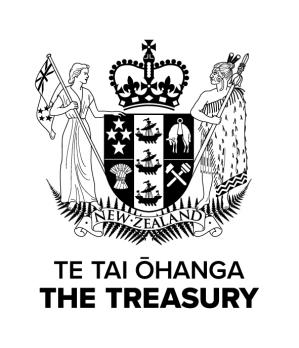
Reference: 20230566
29 January 2024
Andrew Riddell
[FYI request #25099 email]
Dear Andrew
Thank you for your Official Information Act request, received on 9 December 2023. You
requested the following:
…all advice and communications and assessments by The Treasury, including
advice and communications and assessments to cabinet and/or ministers, relating to
this decision to not prepare regulatory impact analyses and list all the proposed
legislation that this applies to.
Please find enclosed the following documents:
Item
Date
Document Description
Decision
1.
29 November
T2023/1898 – 100 Day Action Plan regulatory
Release in part
2023
commitments: Cabinet’s impact analysis
requirements and New Zealand's international
good regulatory practice obligations
2.
30 November
RE: 100 Day Plan and RIA requirements
Release in full
2023
(except for personal
details)
3.
8 December
Attachment to Item 2: Guidance to departments
Release in full
2023
on the application of Regulatory Impact
Analysis requirements to 100 Day Plan
priorities
I have decided to release the documents listed above, subject to information being withheld
under one or more of the following sections of the OIA, as applicable:
•
section 6(a) – to prevent prejudicing the security or defence of New Zealand or the
international relations of the Government of New Zealand,
•
section 9(2)(a) – to protect the privacy of natural persons, including that of deceased
natural persons,
•
section 9(2)(g)(ii) – to maintain the effective conduct of public affairs through the
protection of such Ministers, members of organisations, officers, and employees from
improper pressure or harassment, and
•
section 9(2)(k) – to prevent the disclosure of information for improper gain or
improper advantage.
1 The Terrace
PO Box 3724
Wellington 6140
New Zealand
tel. +64-4-472-2733
https://treasury.govt.nz
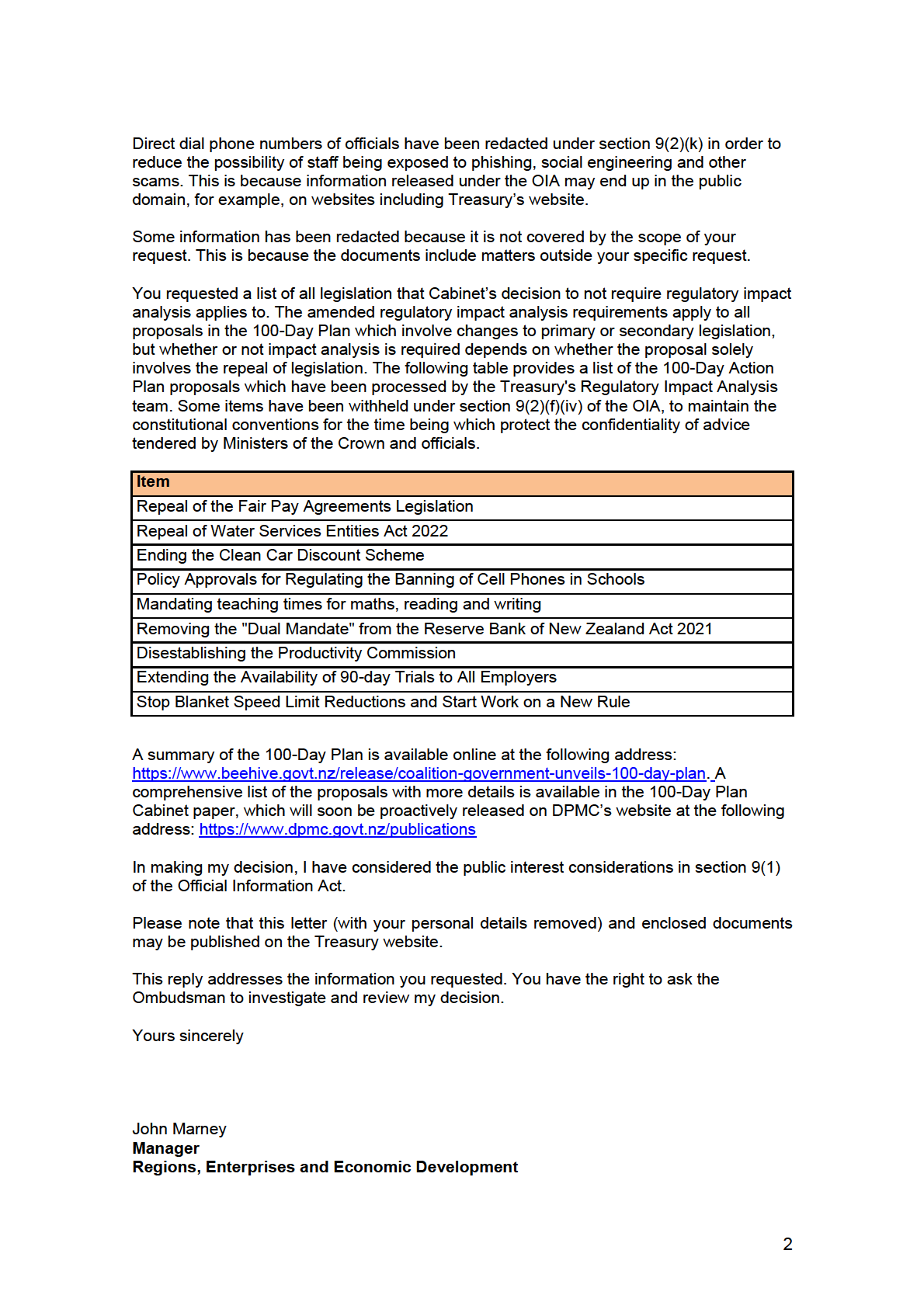
20230566
Table of contents
1.
T2023-1898 100 Day Action Plan regulatory commitments Cabinet’s impact
1
analysis requirements and New Zealand's international good regulatory practice
obligations
2.
RE 100 Day Plan and RIA requirements
15
3.
Guidance to departments on the application of Regulatory Impact Analysis
18
requirements to 100 Day Plan priorities
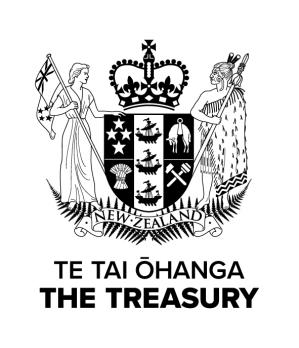
Item 1
Page 1 of 21
IN-CONFIDENCE
Treasury Report: 100 Day Action Plan regulatory commitments: Cabinet’s
impact analysis requirements and New Zealand's
international good regulatory practice obligations
Date:
29 November 2023
Report No:
T2023/1898
File Number:
SH-11-2-7-1
Action sought
Action sought
Deadline
Hon David Seymour
Note our recommended approach to the impact
29 November 2023
analysis requirements for 100 Day Action Plan
Minister for Regulation
proposals, which we understand is reflected in
the Prime Minister’s 100 Day Action plan Cabinet
paper.
Out of scope
Hon Nicola Willis
Note the contents of this briefing.
N/A
Minister of Finance
Contact for telephone discussion (if required)
Name
Position
Telephone
1st Contact
Floris de Meijer
Analyst,
s 9(2)(k) & s 9(2)(g)(ii)
Regulatory Strategy
Harry Chapman
Senior Analyst,
Regulatory Strategy
Pip van der Scheer
Manager, Regulatory
✓
Strategy
Minister’s Office actions (if required)
Return the signed report to Treasury.
Note any
feedback on
the quality of
the report
Enclosure:
N/A
Treasury:4893188v1
IN-CONFIDENCE
Item 1
Page 2 of 21
IN-CONFIDENCE
Treasury Report: 100 Day Action Plan regulatory commitments:
Cabinet’s impact analysis requirements and New Zealand’s international
good regulatory practice obligations
Executive Summary
The Government has indicated an intention to progress a range of policy proposals in its first
100 days. The time constraints in this context have implications for the way in which we meet
our international obligations and operationalise the regulatory impact analysis (RIA)
requirements.
The Government has indicated a focus on good regulatory quality and minimising the impact
of regulation on businesses and individuals. The Regulatory Management System, of which
RIA is a part, plays an important role in helping the Government to achieve this goal. RIA is a
key tool for supporting evidence-based policy development, supporting transparency and
accountability of regulatory decisions and the provision of free and frank advice. The
requirements set in the 100 Day Action Plan period provide an opportunity to set
expectations of good regulatory practice for Ministers and agencies for the rest of the term.
The application of impact analysis requirements to 100 Day Action Plan proposals
The context of the 100 Day Action Plan can make completing comprehensive regulatory
impact analysis impractical. There is no standing exemption for urgent proposals in the 100
Day Action Plan. We do not recommend completely suspending the requirements so
agencies can provide Ministers with the best advice possible and continue to meet New
Zealand’s international obligations. However, we recommend suspending the requirement for
formal quality assurance of Regulatory Impact Statements for 100 Day Action Plan proposals
and requiring post-implementation reviews for all proposals one year after the relevant
legislation is enacted (unless waived by the Treasury).
This approach enables a streamlining of the requirements to enable the delivery of 100 Day
Action Plan proposals, while ensuring we continue to meet New Zealand’s international
obligations and assess regulatory quality in these areas. We understand this approach to
impact analysis is reflected in the Prime Minister’s 100 Day Action Plan Cabinet paper.
Out of scope
T2023/1898 100 Day Action Plan regulatory commitments: Cabinet’s impact analysis requirements and New Zealand's
international good regulatory practice obligations
Page 2
IN-CONFIDENCE
Item 1
Page 3 of 21
IN-CONFIDENCE
Recommended Action
We recommend that you:
a
note that the context of the 100 Day Action Plan can make completing comprehensive
regulatory impact analysis impractical
Noted
Minister for Regulation
b
note officials intend to issue guidance indicating where agencies should focus their
efforts in relation to impact analysis if they are subject to time constraints
Noted
Minister for Regulation
c
note that the Prime Minister has overall responsibility for Cabinet processes and
circulars, including Cabinet’s impact analysis requirements
Noted
Minister for Regulation
d
note we understand the following approach to the impact analysis requirements has
been incorporated into the Prime Minister’s 100 Day Action Plan Cabinet paper:
a. suspending the requirement for quality assurance of Regulatory Impact
Statements
b. requiring post-implementation reviews be undertaken 12 months after the
legislation is enacted, unless this requirement is waived by the Treasury
Noted
Minister for Regulation
Out of scope
T2023/1898 100 Day Action Plan regulatory commitments: Cabinet’s impact analysis requirements and New Zealand's
international good regulatory practice obligations
Page 3
IN-CONFIDENCE
Item 1
Page 4 of 21
IN-CONFIDENCE
Out of scope
Caralee McLiesh
Secretary to the Treasury
_____/_____/_______
Hon David Seymour
Hon Nicola Willis
Minister for Regulation
Minister of Finance
_____/_____/_______
_____/_____/_______
T2023/1898 100 Day Action Plan regulatory commitments: Cabinet’s impact analysis requirements and New Zealand's
international good regulatory practice obligations
Page 4
IN-CONFIDENCE
Item 1
Page 5 of 21
IN-CONFIDENCE
Treasury Report: 100 Day Action Plan regulatory commitments:
Cabinet’s impact analysis requirements and New
Zealand's international good regulatory practice
obligations
Purpose of Report
1.
This report provides advice on the process for 100 Day Action Plan regulatory
commitments. New Zealand has international good regulatory practice (GRP)
obligations which apply to these commitments, including requirements to consult and
prepare regulatory impact analysis (RIA).
2.
This report outlines our recommended approach for how agencies should approach
RIA for 100 Day Action Plan proposals and explains our underlying reasoning. We
understand this approach has been reflected in the Prime Minister’s 100 Day Action
Plan Cabinet paper.
The 100 Day Action Plan and regulatory impact analysis
3.
The Government has indicated a focus on good regulatory quality and minimising the
impact of regulation on businesses and individuals. The Regulatory Management
System (RMS), of which RIA is a part, plays an important role in helping the
Government to achieve this goal. As set out below, impact analysis can help to ensure
Ministers have full information on the costs and benefits of proposals under
consideration, as well as implementation considerations and risks. Analysis at the
beginning of the process can minimise the risk of unintended consequences and
maximise the chance of policies being successfully implemented and ultimately
achieving their objectives. The requirements set in the 100 Day Action Plan period
provide an opportunity to set expectations of good regulatory practice for the rest of the
term.
Background on impact analysis
4.
Cabinet’s impact analysis requirements are set out in Cabinet Office circular CO (20) 2.
The requirements apply to any government regulatory proposal taken to Cabinet for
approval. A “government regulatory proposal” is a proposal that wil ultimately require
creating, amending, or repealing primary or secondary legislation.
5.
RIA is a key tool for supporting evidence-based policy development, supporting
transparency and accountability of regulatory decisions and the provision of free and
frank advice. Impact analysis provides insight into the implications of a proposal,
including any risks or unintended consequences.
6.
The key product of the requirements is a Regulatory Impact Statement (RIS). Under
the status quo, any government regulatory proposals would need to be supported by a
RIS unless an exemption is applicable. The RIS is a government agency document that
summarises an agency’s best impact analysis relating to a regulatory proposal.
7.
The impact analysis framework involves defining the policy or operational problem,
identifying the policy objectives, and the full range of feasible options for addressing
that problem. RISs also provide the basis for consultation with stakeholders, and
effective consultation must be undertaken when carrying out impact analysis. Through
T2023/1898 100 Day Action Plan regulatory commitments: Cabinet’s impact analysis requirements and New Zealand's
international good regulatory practice obligations
Page 5
IN-CONFIDENCE
Item 1
Page 6 of 21
IN-CONFIDENCE
routine publication of RISs, the impact analysis requirements also contribute to
transparency and accountability.
8.
The following table sets out various aspects of the usual impact analysis process:
Impact analysis A Regulatory Impact Statement (RIS) is developed to be
attached to the Cabinet paper. The RIS usually includes:
• a problem definition,
• objectives and criteria,
• analysis of a range of feasible options,
• cost-benefit analysis on the preferred option,
• stakeholder views, and
• implementation considerations and a plan to undertake
monitoring, evaluation and review.
Quality
All impact analysis must undergo independent quality assurance
assurance of
(QA) before being attached to the Cabinet paper. Most QA is
impact
undertaken by agencies, but the Treasury assures the quality of
analysis
RISs for significant proposals.
The QA panel provides the RIS with a rating of ‘meets’, ‘partially
meets’, or ‘does not meet’. The QA panel inserts a formal QA
statement into the Cabinet paper setting out the rating and
providing information on the quality of the analysis and any
limitations or concerns.
Publication
RISs (subject to any redactions) must be published on the
websites of the administering agency and the Treasury,
generally within 30 days of Cabinet making a decision.
Implications if
If no RIS is provided, or it ‘does not meet’ the QA standard, the
requirements
RIA requirements are not met and the Treasury assesses these
are not met
situations on a case-by-case basis. In some circumstances, we
may determine that a Supplementary Analysis Report could be
provided at the next major policy decision at a Cabinet
Committee meeting. Alternatively, a post-implementation review
may be required if there is no time to provide impact analysis
before the legislation is approved by Cabinet.
9.
There are exemptions available from the RIA process under the Cabinet circular. For
example, exemptions for proposals that have minor impacts on individuals, not for
profits and businesses, or for proposals responding to emergency situations. However,
the urgency of a policy proposal is not in itself sufficient grounds for an exemption.
International obligations and impact analysis
10. The promotion of RIA has been a key feature of OECD and APEC recommendations
on good regulatory practice for many years. New Zealand has also accepted a range of
good regulatory practice obligations through international trade agreements. To a large
extent our current impact analysis requirements, processes and mechanisms meet our
current and impending international obligations. International obligations relating to
impact analysis will also apply to some regulatory actions covered by the 100 Day
Action Plan.
11. Under the Free Trade Agreement between New Zealand and the United Kingdom (the
NZ–UK FTA) New Zealand must “endeavour to carry out proportionate impact
T2023/1898 100 Day Action Plan regulatory commitments: Cabinet’s impact analysis requirements and New Zealand's
international good regulatory practice obligations
Page 6
IN-CONFIDENCE
Item 1
Page 7 of 21
IN-CONFIDENCE
assessments of proposed major regulatory measures” and must publish the findings of
those assessments in a timely manner.1
12. In addition, under the NZ–UK FTA, New Zealand “shal ” maintain processes and
mechanisms for impact assessment that consider:
•
the need for a regulatory measure, including the nature and significance of the
issue the measure is intended to address; and
•
any feasible and appropriate regulatory and non-regulatory options that would
achieve the relevant policy objectives.
13.
s 6(a)
We
discuss the Government’s options for setting expectations for impact analysis on 100
Day actions further below.
The previous Government streamlined the impact analysis requirements for its
100 Day Action Plan commitments
14. In 2017, the incoming Government put in place streamlined impact analysis
requirements to support the implementation of its 100 Day Action Plan. This meant
that:
•
Where time constraints precluded full analysis, agencies were able to note key
limitations or constraints, and then focus on implementation and operation, and
monitoring, evaluation and review.
•
QA was required, but QA panels were not required to assign a formal quality
rating.
•
In situations where RIA was required but not provided, the requirement for
Supplementary Analysis was generally triggered.
15. This streamlined approach to impact analysis was subject to criticism by some civil
society stakeholders, and in the media, on the basis that it did not require agencies to
prepare comprehensive impact analysis. Some stakeholders suggested that post-
implementation review should be mandatory for 100 Day Action Plan commitments.
The Government has options about the application of the impact analysis
requirements to 100 Day priorities
16. The Government has choices about how the RIA requirements will apply to regulatory
proposals that relate to priorities in the 100 Day Action Plan.
17. We do not think that the requirement for impact analysis should be completely waived
for 100 Day priorities for a number of reasons. First, RIA is an important instrument to
1 We have focussed on the UK FTA as it has the strongest obligations which are currently in force. The
CPTPP also contains relatively flexible obligations to “general y encourage” impact analysis to be
conducted by regulatory agencies, and while recognising each party’s specific circumstances and
approach, sets out that impact analysis should fulfil certain requirements. The EU–NZ FTA (not yet in
force) “affirms the intention” of NZ’s regulatory authority to carry out impact assessment in line with its
respective rules and procedures, and notes each regulatory authority should promote the identification
and consideration of certain requirements.
T2023/1898 100 Day Action Plan regulatory commitments: Cabinet’s impact analysis requirements and New Zealand's
international good regulatory practice obligations
Page 7
IN-CONFIDENCE
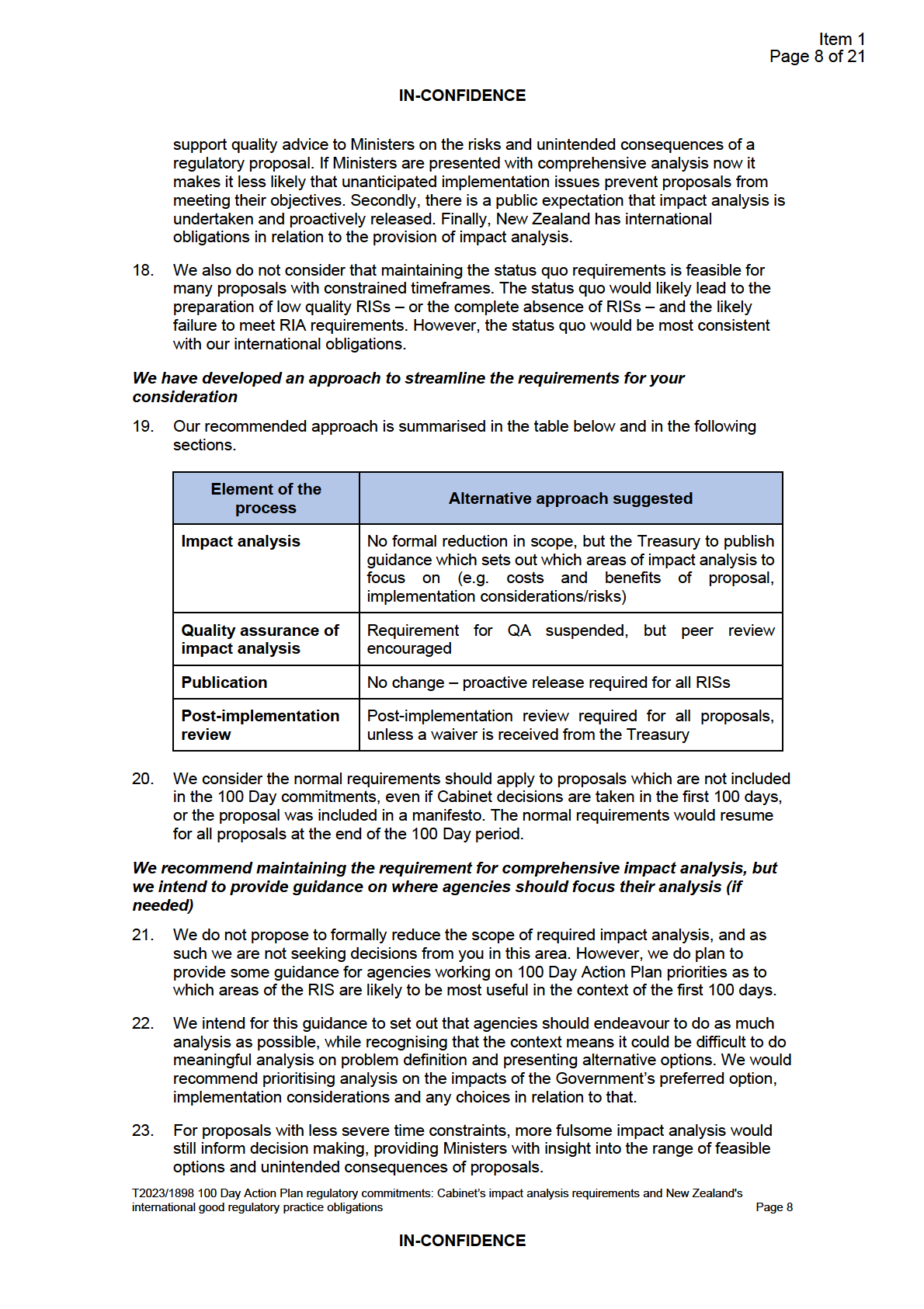
Item 1
Page 9 of 21
IN-CONFIDENCE
24. A full problem definition would be preferred. Where time constraints do not allow for a
complete problem definition, agencies could use the regulatory proposal as set out in
the 100 Day Action Plan priority as the starting point for analysis.
25. In some situations, it may be relevant to refer to previous impact analysis to advise
Cabinet, to streamline the preparation of impact analysis further.2
26. We consider this approach would be consistent with New Zealand’s obligations for
impact analysis to be produced.
We recommend removing the mandatory requirement for quality assurance of RISs
27. In recognition of time pressures and limited departmental resources being available, we
recommend QA of RISs for 100 Day Action Plan priorities be strongly encouraged but
not mandatory. Where formal QA is not undertaken
•
agencies should at a minimum get the RIS peer reviewed within the agency (but
no formal rating would be required), and
•
the authors of the RIS would insert a brief statement into the QA section of the
RIS, and the ‘impact analysis’ section of the Cabinet paper, noting that the RIS
has not been quality assured and setting out the self-identified limitations of the
impact analysis.
28. By not requiring QA, Ministers would not have an independent view on the quality of
the analysis and would instead need to rely on the self-described limitations. However,
it would allow agencies to devote more time to preparing the analysis in the first place.
29. Our international obligations do not require that QA is undertaken, so we have more
freedom to temporarily amend this part of the system.
30. On balance, we consider this approach is most likely to enable the timely delivery of
policy proposals, while still providing some insight into the quality of the analysis
produced. (We have included additional analysis on other options in appendix one.)
We recommend requiring post-implementation reviews of 100 Day Action Plan
proposals
31. Post-implementation review is often required when impact analysis has not been
completed prior to Cabinet approval, or it was completed to an unsatisfactory standard,
and then the regulatory change has been implemented. Conducting a post-
implementation review can provide a useful safeguard to ensure that the change is
meeting its objectives and can identify potential improvements.
32. We recommend all regulatory proposals should be subject to a post-implementation
review one year after the legislation is enacted unless the Treasury’s RIA team waives
the requirement. Where the relevant agency considered post-implementation review
would not be useful (e.g. because the change involves reverting to the previous status
quo), they could seek a waiver from the Treasury’s RIA Team, who would consider
factors such as the significance of the proposal, risks, etc. (We have included
additional analysis on other options in appendix one.)
33. Post-implementation reviews are relatively recent innovations in the RIA system,
agency capability to conduct evaluations is limited, and there can be challenges
2 For example, where the 100 Day Plan priority repeals a piece of legislation, the impact analysis section
could refer to the published previous RIS completed. Agencies can then focus new impact analysis on
current implementation and transitional issues. When Cabinet is agreeing to both repeal legislation and
agree on a replacement that is not just a reversion to the previous status quo, new analysis would be
required in relation to the replacement proposal.
T2023/1898 100 Day Action Plan regulatory commitments: Cabinet’s impact analysis requirements and New Zealand's
international good regulatory practice obligations
Page 9
IN-CONFIDENCE
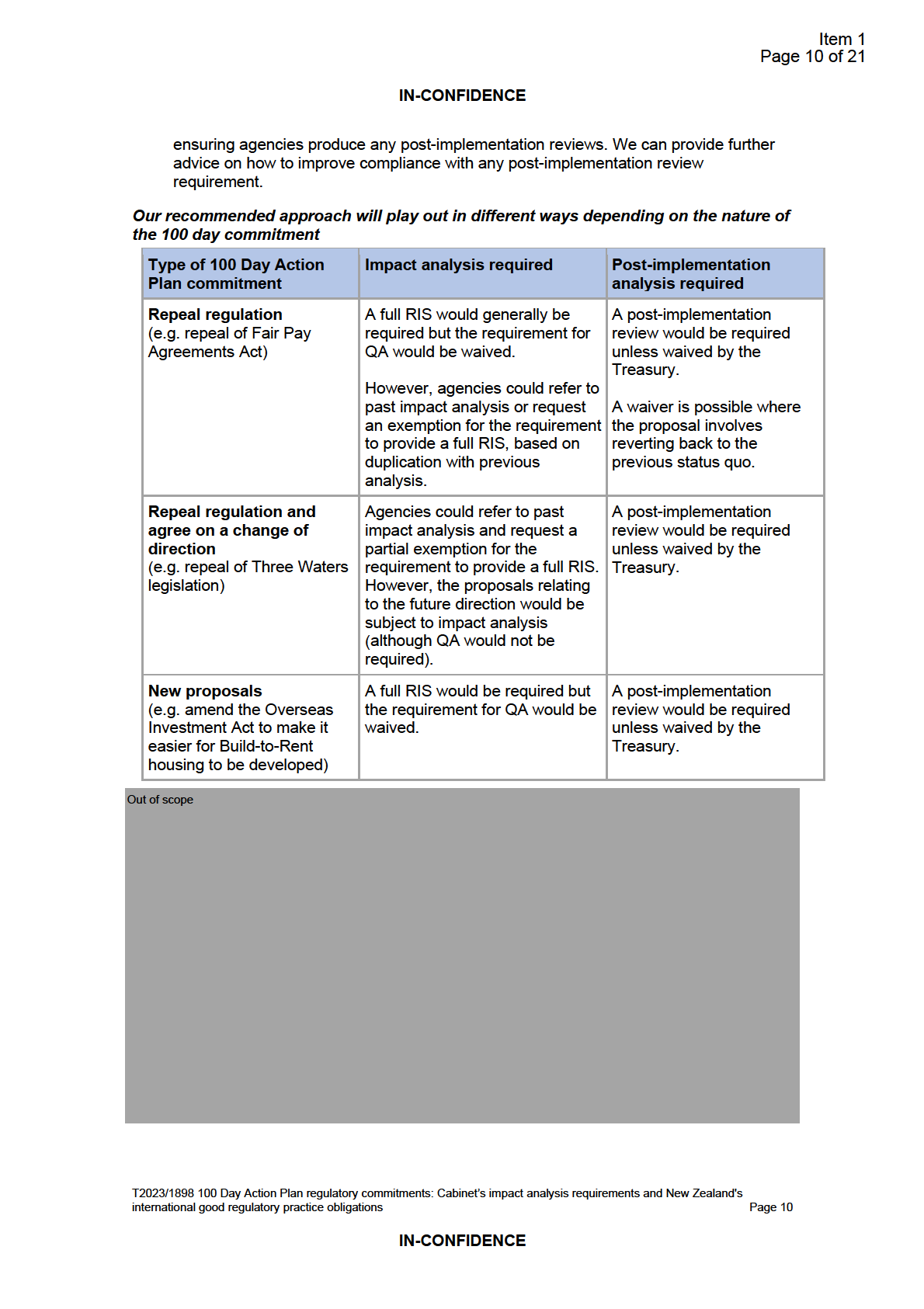
Item 1
Page 11 of 21
IN-CONFIDENCE
Out of scope
Out of scope
T2023/1898 100 Day Action Plan regulatory commitments: Cabinet’s impact analysis requirements and New Zealand's
international good regulatory practice obligations
Page 11
IN-CONFIDENCE
Item 1
Page 12 of 21
IN-CONFIDENCE
Out of scope
Next Steps
49. It has been past practice to include the revised impact analysis requirements in the
Government’s 100 Day Action Plan Cabinet paper. We have worked with the
Department of the Prime Minister and Cabinet on the 100 Day Action Plan Cabinet
paper, and we understand our recommended approach to impact analysis is reflected
in the paper.
50. Once Cabinet has made decisions on the 100 Day Action Plan, the Treasury would
then publish guidance and communicate the requirements to relevant agencies.
T2023/1898 100 Day Action Plan regulatory commitments: Cabinet’s impact analysis requirements and New Zealand's
international good regulatory practice obligations
Page 12
IN-CONFIDENCE
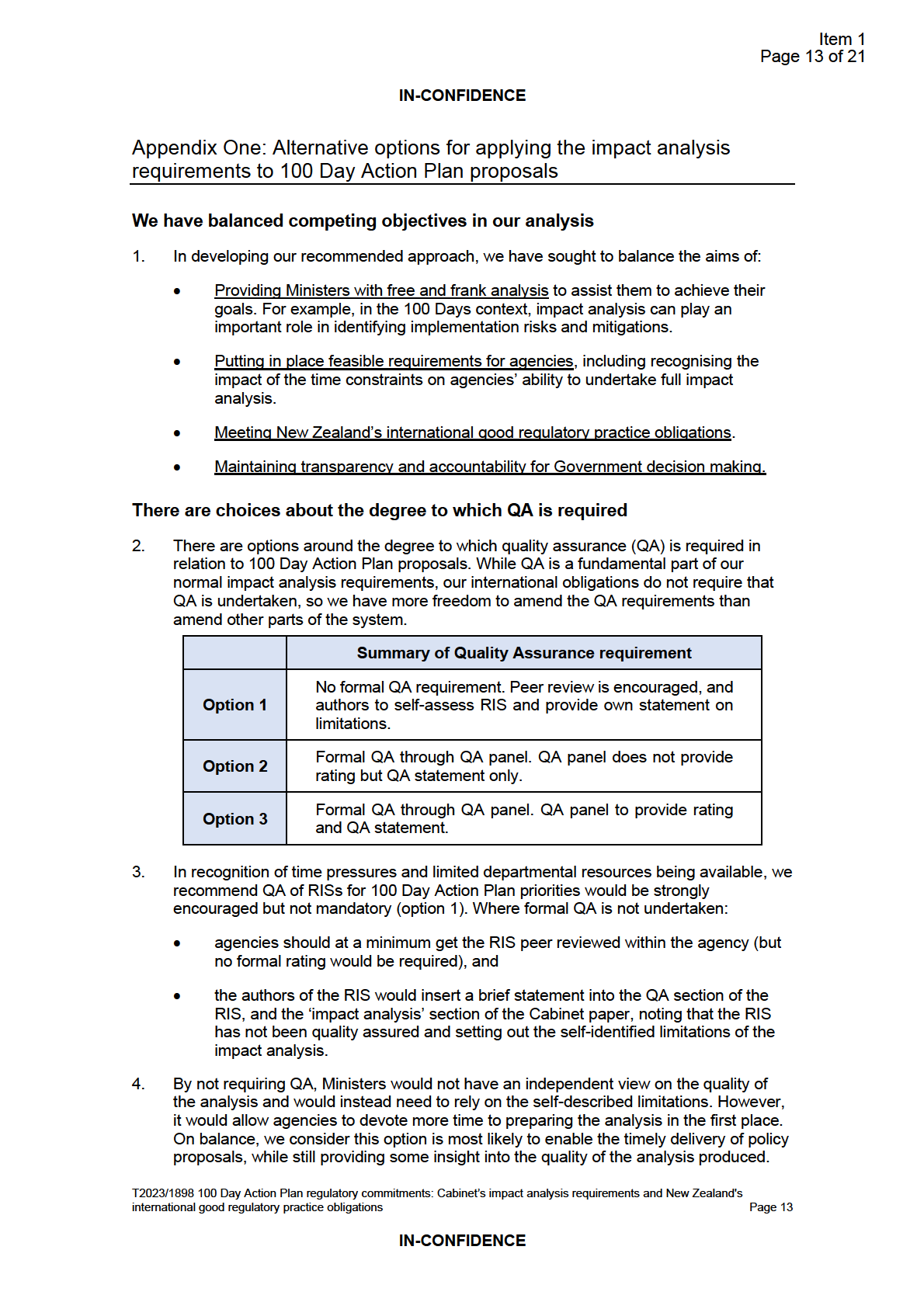
Item 1
Page 14 of 21
IN-CONFIDENCE
5.
We do not recommend the other options:
•
Option 2 would provide Minsters with a better overview of the quality of the
analysis, but it would be significantly more time consuming than option 1.
•
Option 3 (the status quo) would provide the most robust quality assurance of
impact analysis produced, but it would be time consuming and may be an
impediment to the delivery of priority proposals.
Choices about whether 100 Day Action Plan proposals require post-
implementation review
6.
We recommend all regulatory proposals should be subject to a post-implementation
review one year after the legislation is enacted unless the Treasury waives the
requirement. Where the relevant agency considered post-implementation review would
not be useful (e.g. because the change involves reverting to the previous status quo),
they could seek a waiver from the Treasury, who would consider factors such as the
significance of the proposal, risks, etc.
7.
We considered an alternative approach where the Treasury would consider on a case-
by-case basis whether to require post-implementation review, which would result in a
reduced volume of reviews. However, we ultimately concluded all proposals should be
subject to post-implementation review unless this requirement is explicitly waived. This
additional requirement for evaluation reflects the fact that the requirement for QA is
being dropped – so the quality of the impact analysis which is produced is likely to be
lower – but also that the 100 Day Action Plan process condenses the usual policy
process and may increase the chance of mistakes or unanticipated effects.
T2023/1898 100 Day Action Plan regulatory commitments: Cabinet’s impact analysis requirements and New Zealand's
international good regulatory practice obligations
Page 14
IN-CONFIDENCE
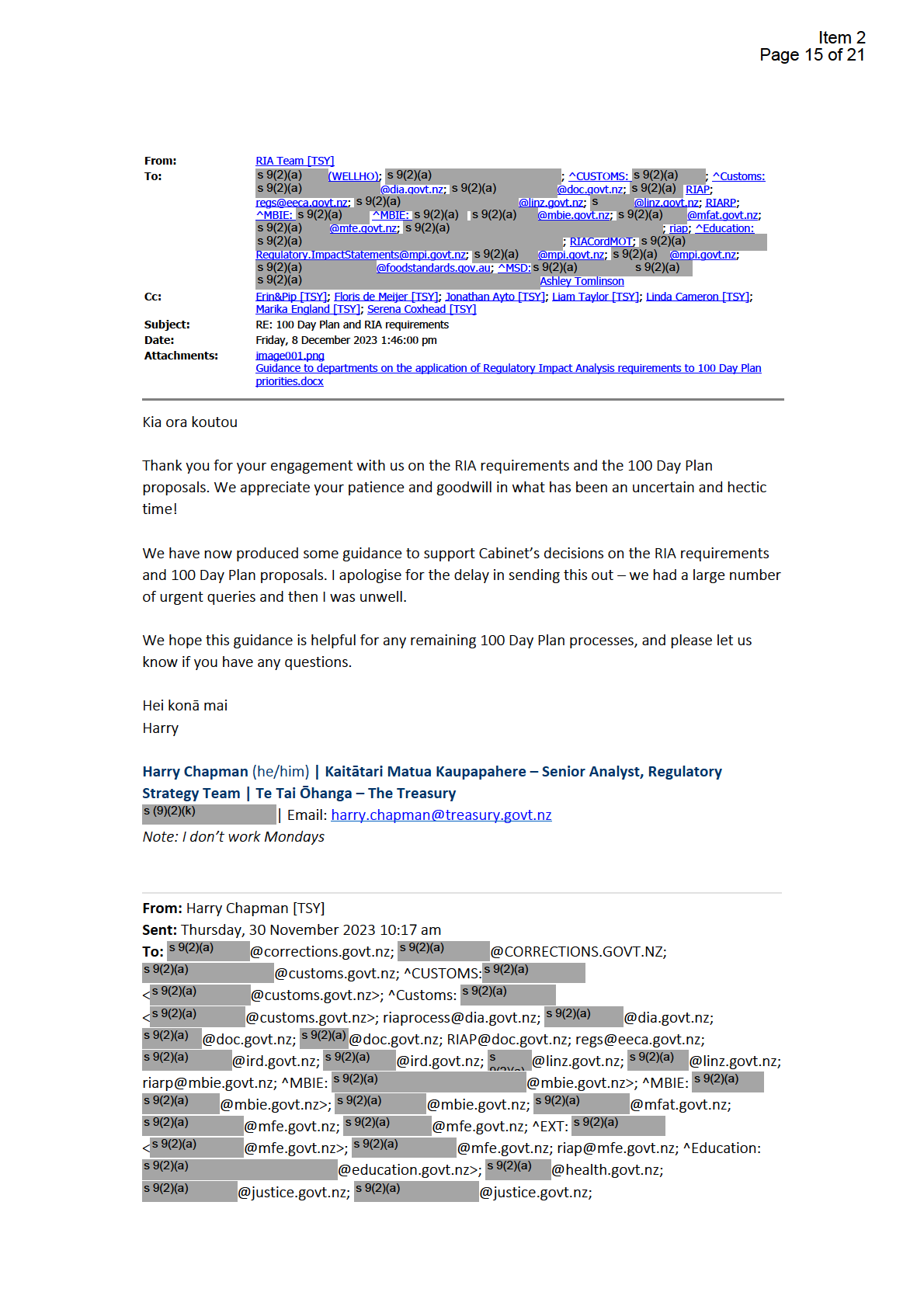
Item 2
Page 16 of 21
[email address]; s 9(2)(a)
@transport.govt.nz; s 9(2)(a) @transport.govt.nz;
[email address]; s 9(2)(a)
@mpi.govt.nz;
s 9(2)(a)
@mpi.govt.nz; s 9(2)(a)
@mpi.govt.nz; s 9(2)(a)
@foodstandards.gov.au;
^MSD: s 9(2)(a)
@msd.govt.nz>; s 9(2)(a)
@msd.govt.nz;
s 9(2)(a)
@ot.govt.nz; s 9(2)(a)
@ot.govt.nz; s 9(2)(a)
@police.govt.nz;
s 9(2)(a)
@rbnz.govt.nz
Cc: Erin&Pip [TSY] <Erin&[email address]>; Floris de Meijer [TSY]
<[email address]>; Jonathan Ayto [TSY] <[email address]>;
Liam Taylor [TSY] <[email address]>; Linda Cameron [TSY]
<[email address]>; Marika England [TSY] <[email address]>;
Serena Coxhead [TSY] <[email address]>
Subject: 100 Day Plan and RIA requirements
Importance: High
[IN-CONFIDENCE]
Kia ora koutou
Cabinet yesterday made decisions on how the RIA requirements will apply to 100 Day Plan
proposals.
If your agency has a Cabinet paper getting lodged imminently for consideration by Cabinet on
Monday please get in touch with us ASAP and we can provide new wording for the impact
analysis section (if it is not too late already).
For proposals involving the repeal of legislation (and not seeking approval for new policy),
no RIS is required
For new proposals:
RISs will be required, but formal quality assurance is not needed (at the very least
we recommend peer review of RISs, and for the authors to note any limitations and
constraints).
If agencies do not have time to prepare comprehensive impact analysis, they can
focus on cost benefit analysis and implementation issues.
Post-implementation assessments will be required, one year after enactment of the
relevant legislation.
In some cases, your agencies will have already started preparing RISs for repeal proposals. Sorry
we haven’t been able to provide clarity before this point on whether or not those RISs were
required. If you have a completed RIS ready to go we recommend they’re still submitted that to
Cabinet, but as the preparation of RISs in that situation is not required we’ll leave the ultimate
decision on whether to submit it to Cabinet up to you and your Minister.
We will be urgently revising our 100 Day Plan guidance and providing that as soon as possible.
Please get in touch if you have any questions.
Hei konā mai
Harry

Item 3
Page 18 of 21
Guidance to departments on the application of Regulatory
Impact Analysis requirements for 100 Day Plan proposals in the
first 100 days
The Treasury’s Regulatory Impact Analysis Team, 8 December 2023
1.
The pace at which advice on regulatory proposals related to priorities in
the 100 Day Plan will need to be developed makes it difficult to fully
comply with the regulatory impact analysis (RIA) requirements in some
cases.
2.
Cabinet has agreed to amend the RIA requirements for 100 Day Plan
proposals [CAB-23-MIN-0468]:
a.
for proposals which solely repeal legislation, the need for a RISs
has been suspended.
b.
for new proposals, RISs are required but formal quality assurance
is not needed. A post-implementation review is also required for
these proposals.
3.
To support Cabinet’s decisions, the Treasury’s RIA Team has developed
this guidance on how to undertake RIA to maximise the quality of advice
delivered to Ministers under very constrained timeframes.
4.
Note that Cabinet’s decisions to amend the RIA requirements for decisions
on 100 Day Plan proposals only apply to
decisions taken during the first
100 days. All other regulatory proposals taken to Cabinet in the 100 Day
period are subject to the normal RIA requirements, as are decisions on
100 Day Plan proposals outside the first 100 Day period (which ends on 8
March 2024).
Engage early with the RIA Team
5.
For 100 Day Plan proposals, please engage early with the Treasury's RIA
Team. The approach to impact analysis will depend on the nature of the
proposal and the RIA team will discuss this with you. The proposal needs
to be entered in RIA Online to confirm the process and template to use
(the exception being if the proposal only repeals legislation, in which case
you can just email the RIA Team).
Cabinet has suspended the need for a RIS for proposals which repeal
legislation
6.
Cabinet has decided that no RIS is required for proposals "repealing
legislation and not seeking approval for new policy”.
7.
Where your proposal is solely repealing legislation, please get in touch
with the RIA Team via email and we can provide wording for the impact
analysis section of the Cabinet paper.
Item 3
Page 19 of 21
8.
There may be some areas of ambiguity where the 100 Day Plan proposal
seeks to partially reverse recent reforms, or repeal legislation and at the
same time agree to what replaces it. In these cases, please discuss the
best approach with the RIA Team.
9.
Despite Cabinet suspending the requirement for RISs for straight repeals
of legislation, your agency may still wish to prepare impact analysis on a
voluntary basis if you are not faced with extreme time pressures. Although
we recommend impact analysis is prepared for all proposals, it is
ultimately a decision for your agency and Minister whether or not this
voluntary impact analysis is prepared and submitted to Cabinet.
The requirements for new proposals have been streamlined
10. If your proposal does trigger the requirements1 and is not eligible for a full
exemption,2 a Regulatory Impact Statement (RIS) will be required and you
will need to seek confirmation of the approach through RIA Online.
11. Cabinet has decided that for new proposals RISs will be required, but
formal quality assurance is not needed.
12. Impact analysis for 100 Day Plan proposals should be as comprehensive
as possible, and should use the standard RIS template as the starting
point.
13. Where constraints prevent comprehensive analysis being undertaken for
100 Day Plan proposals, agencies may wish to focus on:
• An assessment of how the Government’s proposal will meet the policy
objectives, and analysis of the marginal costs and benefits of that
proposal (including a cost-benefit table) [part of section 2 of the
standard RIS template]
• How the proposal will be implemented, including implementation costs
and risks and their mitigation [section 3 of the standard RIS template]
14. If time constraints do not allow for a complete problem definition, agencies
can use the proposed regulatory change set out in the 100 Day Plan as
the starting point for the analysis, in place of a standard problem definition.
Where this is done, it should be clearly flagged in the limitations and
constraints section of the RIS.
1 See Cabinet circular CO (20) 2 for details of what constitutes a ‘government regulatory proposal’ and therefore triggers
the requirements. https://www.dpmc.govt.nz/sites/default/files/2020-06/coc20-2-impact-analysis-requirements.pdf
2 If your proposal does trigger the RIA requirements, you could consider whether it is eligible for an exemption. The
normal grounds for an exemption are available for the 100 Day period. You can apply for an exemption through RIA
Online.
Item 3
Page 20 of 21
Quality assurance (QA)
15. The QA of RISs to support decisions on 100 Day Plan proposals during
the first 100 Day period is strongly recommended but is not mandatory.
16. Where formal QA is not undertaken:
•
agencies should, at a minimum, get the RIS peer reviewed within the
agency (but a formal rating would not be required), and
•
the authors of the RIS should insert a brief statement into the QA
section of the RIS, and the ‘impact analysis’ section of the Cabinet
paper, noting that the RIS has not been quality assured and setting
out the self-identified constraints and limitations of the impact
analysis. In particular, identifying where there are gaps in the
evidence base and uncertainty in the assumptions, and the extent to
which this could impact on the quality of the analysis. The author
may also wish to comment on what further analysis could have been
undertaken with more time.
17. Where formal QA is undertaken, even though it is not required, the panel
may want to focus on identifying limitations with the analysis, rather than
assigning a formal QA rating. The QA panel comment can then be
inserted into the impact analysis section of the Cabinet paper and RIS as
in the normal process.
Publication of RISs for new proposals
18. All RISs must be published, subject to necessary redactions.3 You can
request publication through RIA Online.
Post implementation evaluation of new proposals
19. All 100 Day Plan proposals involving new policy will need to undertake a
post implementation review (PIR) one year after the relevant legislation is
enacted, unless the Treasury’s RIA team provides a waiver. The purpose
of the PIR is to analyse the impacts after the proposal has been
implemented, focussing on whether the proposal’s objectives have been
achieved. The PIR may be used to inform decisions about any refinements
or adjustment required going forward.
20. The RIA Team will discuss with you whether a PIR would be useful and
what it should cover. Whether or not a PIR is required does not need to be
determined before the proposal and RIS are considered by Cabinet.
3 As set out in our guidance, publication is required at the earliest of the following situations: any resulting Bill is
introduced into the House or Supplementary Order Paper is released; any resulting regulation is gazetted; the
government announces its decision not to regulate; when Ministers approve the publication of a RIA under Cabinet’s
proactive release requirements for Cabinet papers.
Item 3
Page 21 of 21
Compliance with these requirements
21. The RIA Team will be monitoring compliance with these requirements in
relation to 100 Day Plan proposals.
22. Where a RIS is required but not provided, the Treasury will work with
agencies on a case-by-case basis to determine next steps.







